Two inclined frictionless tracks, one gradual and the other steep meet at A from where to stones are allowed to slide down from rest, one on each track (fig.) Will hte stones reach the bottom at the same time? Will they reach there with the same speed? Explain, given θ1=30∘, θ92)=60∘ and h=10m. What are the speeds and time taken by the two stones?
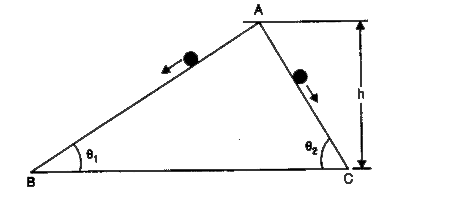 Solution in Tamil
Solution in Tamil
No, the stone on the steep plane reaches the bottom earlier, yes, they reach with the same speed v, [since mgh=(1/2)mv2]
vB=vc=14.1ms−1,tB=2√2s,tc=2√2s.
Topper's Solved these Questions
- BOOK - NCERT TAMILCHAPTER - WORK, ENERGY AND POWEREXERCISE - EXAMPLE36videos
WORK, ENERGY AND POWER
- BOOK - NCERT TAMILCHAPTER - WORK, ENERGY AND POWEREXERCISE - EXERCISE - MULTIPLE CHOICE QUESTIONS15videos
WORK, ENERGY AND POWER
- BOOK - NCERT TAMILCHAPTER - WORK, ENERGY AND POWEREXERCISE - EXERCISES46videos
WORK, ENERGY AND POWER
- BOOK - NCERT TAMILCHAPTER - WAVESEXERCISE - EVALUATION(IV. NUMERICAL PROBLEMS)7videos
WAVES
Similar Questions
A box is pulled with a force of 25 N to produce a displacement of 15 m. If the angle between the force and displacement is 30∘, find the work done by the force.
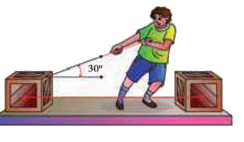 06:38View Solution
06:38View SolutionA uniform force of (2ˆi+ˆj)N acts on a particle of mass 1 kg. The particle displaces from position (3ˆj+ˆk)m to (5ˆi+3ˆj)m. The work done by the force on the particle is
03:00View SolutionThe sign of work done by a force is important to understant. State carefully if the following quantities are positive or negative. (a) Work done by a man in lifting a bucket out of a well by means of a rope tied to the bucket. (b) Work done by the gravitational force in the above case. (c ) Work done by friction on a body sliding down an inclined plane. (d) Work done by an applied froce on a body moving on a rough horizontal plane with uniform velocity. (e ) Work done by the resistive force of air on a vibrating pendulum in bringing it to rest.
03:59View SolutionThe speed of a wave in a certain medium is 900 m/s. If 3000 waves passes over a certain point of the medium in 2 minutes, then compute its wavelength?
04:36View SolutionTwo inclined frictionless tracks, one gradual and the other steep meet at O, from where two stones are allowed to slide down from rest, one on each track. Will the stones reach the bottom at the same time ? Will they reach there with the same speed ? Explain.
14:56View SolutionTwo inclined frictionless tracks, one gradual and the other steep meet at a from where two stones are allowed to slide down from rest, one on each track as shown in Figure. Which of the following statement is correct ?
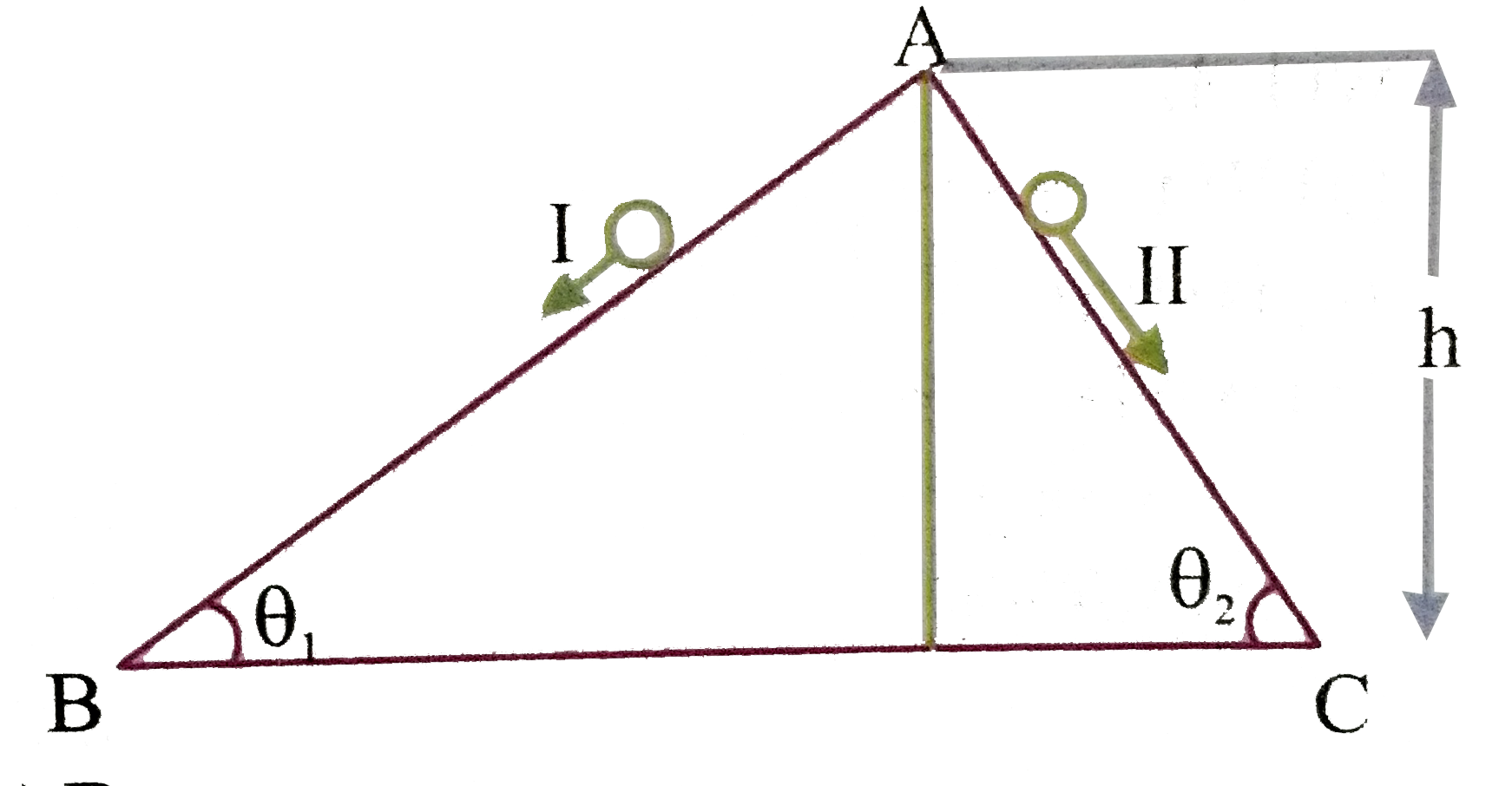 .05:40View Solution
.05:40View SolutionTwo inclined frictionless tracks , one gradual and the other sleep meet at A from where two stones are allowed to slide down from rest. One on each track as shown in figure. Which of the following statement is correct?
 08:06View Solution
08:06View SolutionTwo inclined frictionless tracks, one gradual and the other steep meet at A from where to stones are allowed to slide down from rest, one on each track (fig.) Will hte stones reach the bottom at the same time? Will they reach there with the same speed? Explain, given θ1=30∘, θ92)=60∘ and h=10m. What are the speeds and time taken by the two stones?
 04:45View Solution
04:45View Solutionदो घर्षणरहित आनत पथ, जिनमे से एक की ढाल अधिक है और दूसरे की ढाल कम है, बिंदु A पर मिलते है। बिंदु A से प्रत्येक पथ पर एक-एक पत्थर को विरामावस्था से नीचे सरकाया जाता है (चित्र)। क्या ये पत्थर एक ही समय पर नीचे पहुँचेंगे? क्या वे वहाँ एक ही चाल से पहुँचेंगे ? व्याख्या कीजिए। यदि θ1=30∘,θ2=60∘ और h=10m दिया है तो दोनों पत्थरों की चाल एवं उनके द्वारा नीचे पहुंचने में लिए गए समय क्या हैं?
View SolutionTwo inclined frictionless tracks, one gradual and the other steep meet at A, from where two stones are allowed to slide down from rest, one on each track. Will the stones reach the bottom at the same time? Will they reach there with the same speed? Given theta_(1)=30^(@),theta_(2)=60^(@),h=10m . What are the speeds and time taken by the two stones?
View Solutionदो घर्षणरहित आनत पथ, जिनमें से एक की ढाल अधिक है और दूसरे की ढाल कम है, बिंदु A पर मिलते हैं । बिंदु A से प्रत्येक पथ पर एक - एक पत्थर को विरामावस्था से नीचे सरकाया जाता है । क्या ये पत्थर एक ही समय पर नीचे पहुँचेंगे ? क्या वे वहाँ एक ही चाल से पहुँचेंगे ? व्याख्या कीजिए । यदि θ1=30∘,θ2=60∘ और h=10m दिया है तो दोनों पत्थरों की चाल एवं उनके द्वारा नीचे पहुँचने में लिए गए समय क्या हैं ?
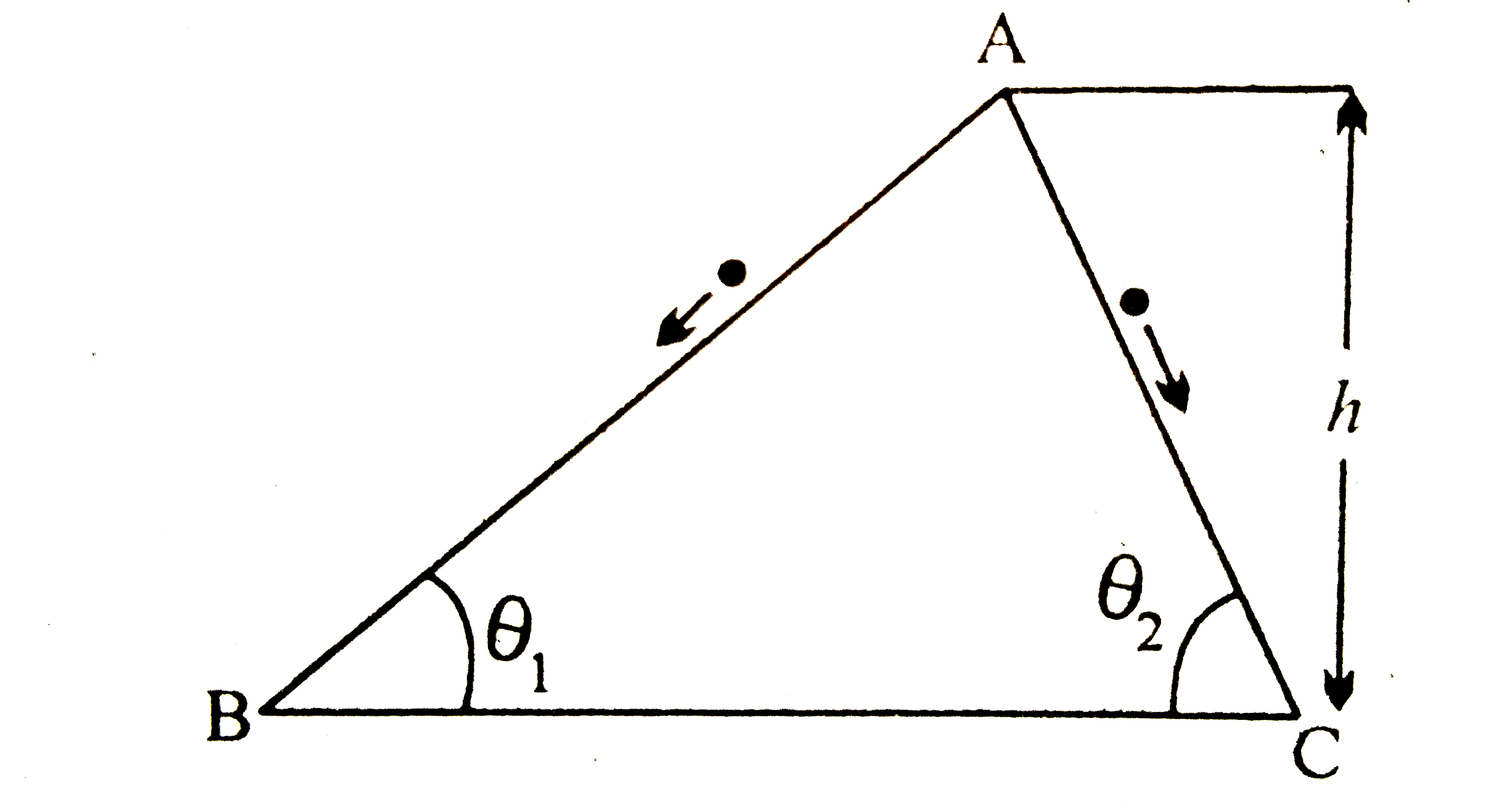 04:47View Solution
04:47View SolutionTwo inclined frictionless tracks, one gradual and other steep meet at 'A' from where two stones are allowed to slide down from rest, one on each track as shown in figure. The speed of two stones on reaching at bottom are v1andv2 respectively. v1&v2 are related as
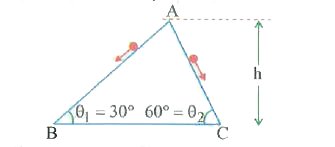 05:20View Solution
05:20View SolutionTwo inclined frictionless tracks, one gradual and the other steep meet at A from where two stones are allowed to slide down from rest, one on each track (Fig. 6.16). Will the stones reach the bottom at the same time? Will they reach there with the same speed? Explain. Given theta_(1)= 30^(@), theta_(2)= 60^(@)" and "h= 10m , what are the speeds and times taken by the two stones?
03:54View SolutionTwo inclined frictionless tracks, one gradual and the other steep meet at A from where two stones are allowed to slide down from rest, one on each track (Fig. 6.16). Will the stones reach the bottom at the same time? Will they reach there with the same speed? Explain. Given theta_(1)= 30^(@), theta_(2)= 60^(@)" and "h= 10m , what are the speeds and times taken by the two stones?
03:07View SolutionTwo inclined frictionless tracks, one gradual and the other steep meet at A from where to stones are allowed to slide down from rest, one on each track (fig.) Will hte stones reach the bottom at the same time? Will they reach there with the same speed? Explain, given theta_(1)=30^(@) , theta_92)=60^(@) and h=10m. What are the speeds and time taken by the two stones?
04:16View SolutionTwo inclined frictionless tracks, one gradual and the other steep meet at A from where two stones are allowed to slide down from rest, one on each track as shown in Figure. Which of the following statement is correct.
View Solution

